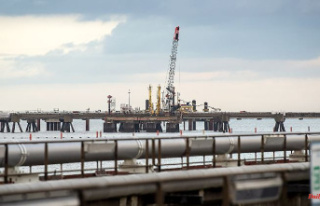Wilhelmshaven as a hub for renewable energies from the North Sea - this is the vision pursued by Lower Saxony's Environment Minister Meyer. After its inauguration, the first German investor for liquefied natural gas will initially transport fossil energy there. It's supposed to start soon.
The first feeder for liquefied natural gas (LNG) in Germany has been completed and opened today, Tuesday. In about a month, a loaded special ship, a so-called floating storage and regasification facility (FSRU), is to dock at the landing site. This emerges from a statement from Niedersachsen Ports, a port operator owned by the state. Niedersachsen Ports had the pier built. Tankers with LNG should then arrive in Wilhelmshaven from mid-January.
"The early decision to choose Wilhelmshaven as a hub for LNG imports was the right one," said Lower Saxony's Economics Minister Olaf Lies at the opening. Lower Saxony's Minister of the Environment, Christian Meyer, said the new investor would make a contribution to security of supply in Lower Saxony and in Germany.
However, he wants to reduce imports of fossil fuels, including natural gas. "The aim is to switch to climate-neutral green gases as quickly as possible and to make Wilhelmshaven the hub for green hydrogen and the import of renewable energies from the North Sea," said Meyer. Construction work on the landing site began in May of this year.
Another FSRU in Wilhelmshaven is scheduled to go into operation at the end of 2023. As the Lower Saxony Ministry of the Environment made clear in a statement, there should be no more than two of the special ships at the site. Instead, an onshore terminal is to be built to replace an FSRU.
In view of the increasingly uncertain Russian natural gas deliveries, the federal government is pushing ahead with the import of liquid gas. So far, however, the necessary import terminals have been missing. LNG is frozen at minus 162 degrees, transported in liquid form by ship, landed, heated, regasified and then fed into the networks.












